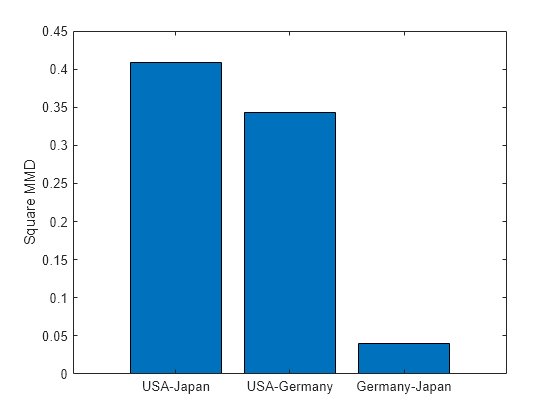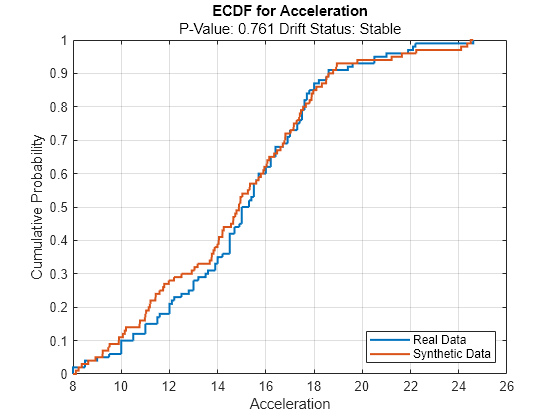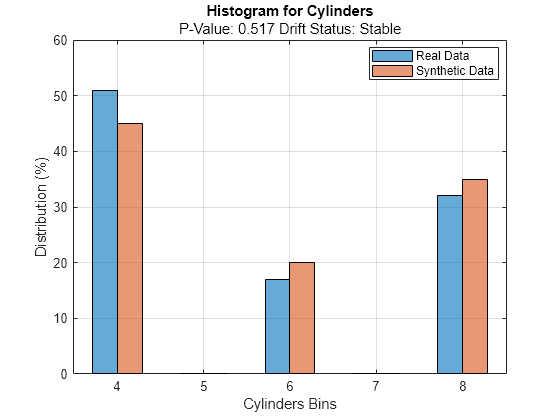mmdtest
Two-sample multivariate hypothesis test using maximum mean discrepancy (MMD)
Since R2024b
Syntax
Description
mmdval = mmdtest(X,Y,Name=Value)
[
also returns the test decision mmdval,p,h] = mmdtest(___)h for the null hypothesis that the
multivariate data sets X and Y come from the same
distribution. The alternative hypothesis is that X and
Y come from different distributions. The result
h is 1 if the test rejects the null hypothesis at
the 5% significance level, and 0 otherwise.
Examples
Calculate and compare the square MMD values for cars manufactured in the USA, Japan, and Germany to determine which two countries have the most similar distribution of automobile measurements between 1970 and 1982.
Load the carbig data set, which contains measurements of cars manufactured from 1970 to 1982. Create a table from this data and display the first eight rows.
load carbig carData = table(Acceleration,Cylinders,Displacement, ... Horsepower,Model_Year,Origin,MPG,Weight); head(carData)
Acceleration Cylinders Displacement Horsepower Model_Year Origin MPG Weight
____________ _________ ____________ __________ __________ _______ ___ ______
12 8 307 130 70 USA 18 3504
11.5 8 350 165 70 USA 15 3693
11 8 318 150 70 USA 18 3436
12 8 304 150 70 USA 16 3433
10.5 8 302 140 70 USA 17 3449
10 8 429 198 70 USA 15 4341
9 8 454 220 70 USA 14 4354
8.5 8 440 215 70 USA 14 4312
The Origin data is stored in a character array. Convert this data to strings for easier manipulation.
carData.Origin = strtrim(string(carData.Origin));
Create separate tables containing all the data for cars manufactured in the USA, Japan, and Germany.
carUSA = carData(carData.Origin=="USA",:); carJapan = carData(carData.Origin=="Japan",:); carGermany = carData(carData.Origin=="Germany",:);
Create a vector containing the names of all the variables except Origin. Because the data sets have different values for Origin, omit this variable from the square MMD value computation.
variableNames = ["Acceleration","Cylinders","Displacement", ... "Horsepower","Model_Year","MPG","Weight"];
Use the mmdtest function to calculate the square MMD value for the USA and Japan data sets, the USA and Germany data sets, and the Germany and Japan data sets. Specify which variables to include in the computation by using the VariableNames name-value argument.
mmdUSAJapan = mmdtest(carUSA,carJapan,VariableNames=variableNames); mmdUSAGermany = mmdtest(carUSA,carGermany,VariableNames=variableNames); mmdGermanyJapan = mmdtest(carGermany,carJapan,VariableNames=variableNames);
Display the three square MMD values. Recall that the square MMD is a measurement of distance used to quantify the difference between two distributions. In general, a smaller square MMD value indicates greater similarity between two data sets.
countries = ["USA-Japan","USA-Germany","Germany-Japan"]; mmdValues = [mmdUSAJapan,mmdUSAGermany,mmdGermanyJapan]; bar(countries,mmdValues) ylabel("Square MMD")

The bar graph shows that Germany and Japan have the smallest square MMD value. This result indicates that Germany and Japan have the most similar distribution of car measurements between 1970 and 1982.
Perform a two-sample hypothesis test using the square MMD value to determine if two iris species have the same distribution of sepal and petal dimensions. The null hypothesis of the test is that the data sets for the two iris species come from the same distribution. The alternative hypothesis is that the data sets come from different distributions.
First, perform a hypothesis test on two samples of iris data with even numbers of each iris species. Load the fisheriris data set into a table and display the first eight rows.
fisheriris = readtable("fisheriris.csv");
head(fisheriris) SepalLength SepalWidth PetalLength PetalWidth Species
___________ __________ ___________ __________ __________
5.1 3.5 1.4 0.2 {'setosa'}
4.9 3 1.4 0.2 {'setosa'}
4.7 3.2 1.3 0.2 {'setosa'}
4.6 3.1 1.5 0.2 {'setosa'}
5 3.6 1.4 0.2 {'setosa'}
5.4 3.9 1.7 0.4 {'setosa'}
4.6 3.4 1.4 0.3 {'setosa'}
5 3.4 1.5 0.2 {'setosa'}
Split the data set into two samples with even distribution of the species.
cv = cvpartition(fisheriris.Species,"Holdout",0.5);
sample1 = fisheriris(cv.training,:);
sample2 = fisheriris(cv.test,:);Perform a hypothesis test at the 1% significance level using the mmdtest function.
[mmdValue,p,h] = mmdtest(sample1,sample2,Alpha=0.01)
mmdValue = 0.0048
p = 0.9200
h = 0
The returned test decision of h = 0 indicates that mmdtest fails to reject the null hypothesis that the samples come from the same distribution at the 1% significance level. The low value of mmdValue suggests that the samples have similar distributions.
Next, perform a hypothesis test to compare the distribution of petal and sepal data for the setosa and virginica iris species. Create separate tables containing the data for the setosa and virginica iris species.
setosa = fisheriris(string(fisheriris.Species)=="setosa",:); virginica = fisheriris(string(fisheriris.Species)=="virginica",:);
Store the sepal and petal data for each species in a numeric matrix.
setosaData = setosa{:,1:end-1};
virginicaData = virginica{:,1:end-1};Perform a hypothesis test at the 1% significance level using the mmdtest function.
[mmdValue,p,h] = mmdtest(setosaData,virginicaData,Alpha=0.01)
mmdValue = 0.5257
p = 0
h = 1
The returned test decision of h = 1 indicates that mmdtest rejects the null hypothesis that the samples come from the same distribution at the 1% significance level. This result indicates that the setosa and virginica iris species have different distributions of sepal and petal data.
Evaluate data synthesized from an existing data set. Compare the existing and synthetic data sets to determine distribution similarity.
Load the carsmall data set. The file contains measurements of cars from 1970, 1976, and 1982. Create a table containing the data and display the first eight observations.
load carsmall carData = table(Acceleration,Cylinders,Displacement,Horsepower, ... Mfg,Model,Model_Year,MPG,Origin,Weight); head(carData)
Acceleration Cylinders Displacement Horsepower Mfg Model Model_Year MPG Origin Weight
____________ _________ ____________ __________ _____________ _________________________________ __________ ___ _______ ______
12 8 307 130 chevrolet chevrolet chevelle malibu 70 18 USA 3504
11.5 8 350 165 buick buick skylark 320 70 15 USA 3693
11 8 318 150 plymouth plymouth satellite 70 18 USA 3436
12 8 304 150 amc amc rebel sst 70 16 USA 3433
10.5 8 302 140 ford ford torino 70 17 USA 3449
10 8 429 198 ford ford galaxie 500 70 15 USA 4341
9 8 454 220 chevrolet chevrolet impala 70 14 USA 4354
8.5 8 440 215 plymouth plymouth fury iii 70 14 USA 4312
Generate 100 new observations using the synthesizeTabularData function. Specify the Cylinders and Model_Year variables as discrete numeric variables. Display the first eight observations.
rng("default") syntheticData = synthesizeTabularData(carData,100, ... DiscreteNumericVariables=["Cylinders","Model_Year"]); head(syntheticData)
Acceleration Cylinders Displacement Horsepower Mfg Model Model_Year MPG Origin Weight
____________ _________ ____________ __________ _____________ _________________________________ __________ ______ _______ ______
11.215 8 309.73 137.28 dodge dodge coronet brougham 76 17.3 USA 4038
10.198 8 416.68 215.51 plymouth plymouth fury iii 70 9.5497 USA 4507.2
17.161 6 258.38 77.099 amc amc pacer d/l 76 18.325 USA 3199.8
9.4623 8 426.19 197.3 plymouth plymouth fury iii 70 11.747 USA 4372.1
13.992 4 106.63 91.396 datsun datsun pl510 70 30.56 Japan 1950.7
17.965 6 266.24 78.719 oldsmobile oldsmobile cutlass ciera (diesel) 82 36.416 USA 2832.4
17.028 4 139.02 100.24 chevrolet chevrolet cavalier 2-door 82 36.058 USA 2744.5
15.343 4 118.93 100.22 toyota toyota celica gt 82 26.696 Japan 2600.5
Visualize the synthetic and existing data sets. Create a DriftDiagnostics object using the detectdrift function. The object has the plotEmpiricalCDF and plotHistogram object functions you can use to visualize continuous and discrete variables.
dd = detectdrift(carData,syntheticData);
Use plotEmpiricalCDF to visualize the empirical cumulative distribution function (ECDF) of the values in carData and syntheticData.
continuousVariable ="Acceleration"; plotEmpiricalCDF(dd,Variable=continuousVariable) legend(["Real Data","Synthetic Data"])

For the variable Acceleration, the ECDF of the existing data (in blue) and the ECDF of the synthetic data (in red) appear to be similar.
Use plotHistogram to visualize the distribution of values for discrete variables in carData and syntheticData.
discreteVariable ="Cylinders"; plotHistogram(dd,Variable=discreteVariable) legend(["Real Data","Synthetic Data"])

For the variable Cylinders, the distribution of data between the bins for the existing data (in blue) and the synthetic data (in red) appear similar.
Compare the synthetic and existing data sets using the mmdtest function. The function performs a two-sample hypothesis test for the null hypothesis that the samples come from the same distribution.
[mmd,p,h] = mmdtest(carData,syntheticData)
mmd = 0.0078
p = 0.8860
h = 0
The returned value of h = 0 indicates that mmdtest fails to reject the null hypothesis that the samples come from different distributions at the 5% significance level. As with other hypothesis tests, this result does not guarantee that the null hypothesis is true. That is, the samples do not necessarily come from the same distribution, but the low MMD value and high p-value indicate that the distributions of the real and synthetic data sets are similar.
Input Arguments
Sample data, specified as a numeric matrix or a table. The rows of
X correspond to observations, and the columns correspond to
variables. mmdtest ignores observations with missing data.
If
XandYare numeric matrices, they must have the same number of variables, but can have different numbers of observations.If
XandYare tables, they must have the same variable names, or the variable names of one must be a subset of the other.XandYcan have different numbers of observations.
mmdtest uses X as reference data to
normalize continuous variables and establish a set of categories for categorical
variables. When a categorical variable is in both X and
Y, the variable in Y cannot contain
categories that are not in X.
Data Types: single | double | table
Sample data, specified as a numeric matrix or table. The rows of
Y correspond to observations, and the columns correspond to
variables. mmdtest ignores observations with missing data.
If
XandYare numeric matrices, they must have the same number of variables, but can have different numbers of observations.If
XandYare tables, they must have the same variable names, or the variable names of one must be a subset of the other.XandYcan have different numbers of observations.
Data Types: single | double | table
Name-Value Arguments
Specify optional pairs of arguments as
Name1=Value1,...,NameN=ValueN, where Name is
the argument name and Value is the corresponding value.
Name-value arguments must appear after other arguments, but the order of the
pairs does not matter.
Example: mmdtest(X,Y,Alpha=0.01,NumPermutations=500) specifies a test
that performs 500 permutations at the 1% significance level.
Significance level of the hypothesis test, specified as a scalar value in the range (0,1).
Example: Alpha=0.01
Data Types: single | double
Number of permutations used to construct the probability distribution for
permutation testing, specified as a positive integer scalar. Permutation testing is
performed only when you specify the output p or
h.
For more information, see Permutation Testing.
Example: NumPermutations=100
Data Types: single | double
Variables to include in the MMD computation, specified as a character vector,
string array, or cell array of character vectors. Because matrices do not have named
variables, this argument applies only when X and
Y are tables.
VariableNamesmust be a subset of the variables shared byXandY.By default,
VariableNamescontains all the variables shared byXandY.
Example: VariableNames=["Name","Age","Score"]
Data Types: char | string | cell
Variables to treat as categorical, specified as one of the values in this table.
| Value | Description |
|---|---|
"all" | All variables contain categorical values. |
| Vector of numeric indices | Each vector element corresponds to the index of a variable, indicating that the variable contains categorical values. |
| Logical vector | A logical vector the same length as VariableNames. A
value of true indicates that the corresponding variable
contains categorical values. |
| String array or cell array of character vectors | An array containing the names of variables with categorical values. The
array elements must be names found in
VariableNames. |
If X and Y are numeric matrices, then
CategoricalVariables cannot be a string array or cell array of
character vectors. By default, mmdtest assumes all variables in
numeric matrices are continuous, and treats table columns of character arrays or
string scalars as categorical variables.
Example: CategoricalVariables="all"
Data Types: single | double | logical | char | string | cell
Options for computing in parallel and setting random streams, specified as a
structure. Create the Options structure using statset. This table lists the option fields and their
values.
| Field Name | Value | Default |
|---|---|---|
UseParallel | Set this value to true to run computations in
parallel. | false |
UseSubstreams | Set this value to To compute
reproducibly, set | false |
Streams | Specify this value as a RandStream object or
cell array of such objects. Use a single object except when the
UseParallel value is true
and the UseSubstreams value is
false. In that case, use a cell array that
has the same size as the parallel pool. | If you do not specify Streams, then
mmdtest uses the default stream or
streams. |
Note
You need Parallel Computing Toolbox™ to run computations in parallel.
Example: Options=statset(UseParallel=true,UseSubstreams=true,Streams=RandStream("mlfg6331_64"))
Data Types: struct
Output Arguments
p-value of the test, returned as a scalar value in the range [0,1].
p is the probability of observing a test statistic that is as
extreme as, or more extreme than, the observed value under the null hypothesis. A small
value of p indicates that the null hypothesis might not be
valid.
Hypothesis test result, returned as 1 or 0.
A value of
1indicates the rejection of the null hypothesis at theAlphasignificance level.A value of
0indicates a failure to reject the null hypothesis at theAlphasignificance level.
More About
The maximum mean discrepancy (MMD) is a measure of distance between the feature means of two independent multivariate distributions. The MMD uses a kernel function to compute the inner product in reproducing kernel Hilbert space (RKHS), and subtracts the cumulative similarity between the data sets from the cumulative similarity of the data sets with themselves. Higher MMD values indicate that the data sets are from different distributions. An MMD value of 0 indicates that the distributions are identical.
mmdtest calculates the biased empirical estimate of the square MMD.
For two data sets X and Y with
m and n observations, the square MMD is
where k represents the kernel function.
Permutation testing is a type of nonparametric hypothesis test that uses resampling to
create a distribution of all possible test statistic values. The sample test statistic is
compared to the generated distribution to calculate the p-value and test
decision. The number of permutations used to generate this distribution is specified by the
NumPermutations name-value argument of the
mmdtest function. Performing more permutations creates a more robust
distribution, but is more computationally intensive.
References
[1] Gretton, Arthur, Karsten M. Borgwardt, Malte J. Rasch, Bernhard Schölkopf, and Alexander Smola. “A Kernel Two-Sample Test.” Journal of Machine Learning Research 13, no. 25 (2012): 723–73. http://jmlr.org/papers/v13/gretton12a.html.
Extended Capabilities
To run computations in parallel, specify the p output argument.
Also, specify the Options name-value argument and set the
UseParallel field of the options structure to true
using statset:
Options=statset(UseParallel=true)
For more information about parallel computing, see Run MATLAB Functions with Automatic Parallel Support (Parallel Computing Toolbox).
Version History
Introduced in R2024b
See Also
synthesizeTabularData | binningTabularSynthesizer | kstest2 | knntest
MATLAB Command
You clicked a link that corresponds to this MATLAB command:
Run the command by entering it in the MATLAB Command Window. Web browsers do not support MATLAB commands.
选择网站
选择网站以获取翻译的可用内容,以及查看当地活动和优惠。根据您的位置,我们建议您选择:。
您也可以从以下列表中选择网站:
如何获得最佳网站性能
选择中国网站(中文或英文)以获得最佳网站性能。其他 MathWorks 国家/地区网站并未针对您所在位置的访问进行优化。
美洲
- América Latina (Español)
- Canada (English)
- United States (English)
欧洲
- Belgium (English)
- Denmark (English)
- Deutschland (Deutsch)
- España (Español)
- Finland (English)
- France (Français)
- Ireland (English)
- Italia (Italiano)
- Luxembourg (English)
- Netherlands (English)
- Norway (English)
- Österreich (Deutsch)
- Portugal (English)
- Sweden (English)
- Switzerland
- United Kingdom (English)